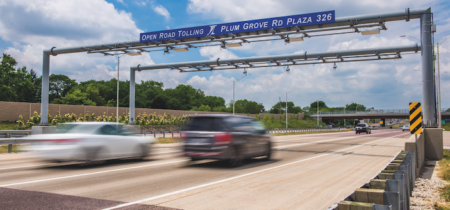With the number of vehicles on US roads increasing each year and more of them being fuel efficient – or even electric, the nation is facing a stark problem in regards to funding improvements to the road network, according to the following white paper issued by A-to-Be.
Home to more than 4.1 million miles of public highway, U.S. arteries are the foundation for the American dream. These are not merely political soundbites – debilitating congestion, underfunded roads and dangerously unstable bridge conditions are economic realities that demand action. In fact, investments in the nation’s infrastructure are among a handful of priorities leaders in Congress agree on. In July, Senators John Barrasso (R-WY) and Tom Carper (D-DE) reaffirmed bipartisan commitment to remedying American roads and bridges. The “America’s Transportation Infrastructure Act” (ATIA) is the largest funding bill proposed for highway reauthorization and authorizes $287 billion over five years for state-led transportation initiatives that will connect Americans, power the economy and withstand the test of time.
Though the size of America’s fleet and total Vehicle Miles Travelled (VMT) are expected to increase over time, the sale of gasoline will continue to decrease as demand for cheaper, more fuel-efficient cars and electric vehicles increases. A fuel tax increase may moderately boost transportation funds, but is unsustainable over time. In fact, Trump’s top economist stated last year, “If we’re all driving around in Tesla’s, then how is the gas tax going to pay to fix the potholes?”.

A stopgap measure is a misuse of taxpayer dollars. Uncertainty complicates long-term planning efforts, stalls investments in capital projects and inhibits commercial productivity. Meanwhile, administrations across the 30 states that have implemented rate hikes have yet to reverse the decline in their transportation funds.
Some argue drivers may respond to an increase in motor fuels taxes by driving less, thereby reducing emissions and lessening the need for construction and maintenance costs. The 12.2 billion additional miles traveled between 2018-2019, however, suggests Americans would prefer fuel efficient and electric vehicles rather than no vehicles at all.
Transportation Funding: How it Works
Much like wireless carriers, state departments of transportation collect revenue in the form of user fees. User fees are paid by the motorist and designated for transportation use in the state. Definitions are legislated by state.
The average driver pays approximately $30–$50 per month in state and federal fuel excise fees depending on unique vehicles’ fuel economies. That range may reach as high as $48–$68 per month accounting for commercial motor vehicle fees and federal transfers. Factoring in payments to contracted entities and debt resolution, state departments of transportation operate on less than 60 percent of total revenues to design, build, operate, and maintain an adequate roadway system.

Current Sources
Transportation revenues are calculated to account for population size, fleet efficiency, degree of commercial traffic, and state-specific regulations. Investments in transportation are funded through: (a) State revenues – state gas excise tax, licensing and registration, motor vehicle sales tax; (b) Federal revenues – highway trust fund, federal gas tax, appropriations; (c) State/Federal general funds. Some states will enact special legislation to allocate other revenue sources or portions of them to support transportation needs, or a small fraction of funds may be allocated from a state’s general revenue fund. In Indiana, for example, one percent of the state’s sales tax is applied to the state Highway Trust fund.
A state’s net transportation revenue is typically allocated across five “buckets.” These buckets account for varying elements of transportation finance and are filled with unique combinations of state and federal funds. Approximately two-thirds of a state transportation fund is supported through state-based fees, while one-fourth to one-third is supplemented by the Federal Highway Administration (FHWA).
State & Federal Excise Taxes
States have historically relied on local gas taxes to sustain their transportation funds. Fuel taxes set by state legislatures reflect fixed prices per gallon. Each gallon of fuel carries an additional
18.4 cents levied on behalf of the federal government and deposited into the Highway Trust Fund. The federal gas tax, nevertheless, has not increased since 1993 and is worth 40% less than it was 25 years ago (1). The Congressional Budget Office estimates the tax would have been approximately 15 cents higher in 2019 had it been indexed for inflation (2). Without additional revenue, the trust fund will become insolvent by 2021, according to the Congressional Budget Office.

Consequently, the federal government’s purchasing power has eroded significantly in recent
years and Congress has had to transfer money from other sources to cover the gap. According to the White House Council of Economic Advisors, a higher gas tax is merely a stopgap. In 2016, federal outlays eclipsed total transportation funds by $10 billion. Some states are already embracing private sector innovation to finance transportation and, despite claims from the U.S. Chamber of Commerce, technology is changing how the transportation system is used, and the way we pay for it must evolve en suite.
Other Transportation Taxes
Additional sources of federal funding flow through taxes on tires, heavy truck and trailer sales, and heavy vehicle use. Typically, about 80 percent of federal public transportation program funding comes from the mass transit account of the Highway Trust Fund and 20 percent comes from the general fund of the U.S. Treasury. Further funds are derived from vehicle registration and licensing fees, as well as taxes on aviation fuel, railroad fees, earned interest and local or neighboring government construction reimbursements.
Federal Appropriations
Current U.S. law governing transportation finance authorizes $300 billion through the Fixing America’s Surface Transportation (FAST) Act to fund federal highway, highway safety, transit, and passenger rail program through 2020. FY 2018 and FY 2019 appropriations provided additional general fund money for several programs, raising the general fund share to about 28 percent in FY 2018 and 26 percent in FY 2019.
Set to expire in 2020, Congress faces mounting political and economic pressure to pass a new federal transportation spending bill that, not only addresses existing concerns, but sets the country on a path towards a sustainable future. According to a summary of the bill issued by the Senate Environment and Public Works Committee, ATIA would: increase funding for the Nationally Significant Freight and Highway Projects program; offer new competitive grant programs; favor project efficiency under the “One Federal Decision” policy; improve resiliency; and reduce carbon emissions.

Shortly thereafter, the Highway Trust fund is expected to run dry in 2021 and estimates from the Government Accountability Office (GAO) indicate the fund may already be underfunded to the tune of some $100 million. Congress has, in the past, allocated fund transfers from the General Budget into the Highway Trust fund to cover such deficits. Congress may reallocate funds to the Highway Trust, but the 2020 election will undoubtedly require candidates put forward robust solutions for U.S. transportation funding.
Viable Alternatives
To supplement depleting revenue sources, state and federal government have considered several solutions:
Tolling – An increasing number of states such as Connecticut, Michigan or Wyoming are working to pass tolling legislation to shore up transportation funding, while several new toll road projects are completed, underway or slated to begin construction in 1-3 years. This year saw new toll roads open in Texas, California, Virginia, Florida, North Carolina, and Oregon.
Congestion Pricing – Commonly cited as one of the most effective tolling tools, congestion pricing has a profound capacity to reduce traffic in and out of major cities. The usage fee works by shifting rush hour highway travel to other modes of transportation or to off-peak hours. New York is the first U.S. city to establish a congestion pricing toll system. Motorists traveling in and out of Manhattan will be charged a flat or variable rate to drive within specific areas of the city during peak times. The toll is projected to generate between $1- $2 billion annually.

Congestion pricing benefits drivers and business by reducing delays and increasing predictability in trip planning. It allows transit authorities to increase speed, reliability and ridership while lowering overhead costs, and benefits state and local governments by improving the quality of transportation services without tax increases or large capital expenditures, by providing additional revenues for funding transportation, by retaining businesses and expanding the tax base, and by shortening incident response times for emergency personnel and thus saving lives.
Managed/Express Lanes – Managed or Express Lanes operate according to demand. Operational strategies for managed lanes enable a high degree of flexibility so that they may be actively managed to respond to changing conditions. These include access control lanes (express and reversible lanes), vehicle eligibility lanes (HOV and truck lane restrictions) and pricing lanes (value priced and toll). Examples of managed lanes are found across the United States.
Road Usage Charge – A growing number of state including Idaho, Minnesota, Oregon, Washington, California, Hawaii, Colorado, and Missouri, as well as the I-95 Corridor Coalition led by the Delaware DOT are actively exploring the viability of a distance-based Road Usage Charge (RUC), often used interchangeably with VMT fees, to either supplement or replace their existing gas tax systems. Each of the states mentioned have implemented legislation permitting lawmakers to convene governing boards, conduct feasibility studies, test-drive pilot programs, and implement mileage-based road user fees.

According to a study published in the Journal of Public Economics, vehicle miles traveled stand to decrease 3.5 billion miles more under a RUC system than they would under a gas tax system. As a result, a VMT tax that raised $55 billion would have an economic effect 20 percent greater than the traditional per-gallon fuel tax.
Public-Private Partnerships – Public-Private Partnerships (P3) are used to deliver public services with the resources, efficiency and innovation afforded by private companies. Under this model, private sector partners take on the design, build, financing, and long-term operation and maintenance responsibilities of the project to guarantee on-time delivery, cost-savings and access to new sources of private capital. The user pays a “toll” to the private company selected by the public entity contracted to operate and maintain a state’s roads.
State Tax, Debt & Credit Mechanisms – States may pursue policies aimed at increasing property taxes, diverting other tax revenues or creating a wholly new tax directed towards the general fund or for earmarked transportation programs. While these sources of revenue depart from the traditional user fee principle, they are, nonetheless, a means by which states may supplement their declining revenue streams.

Summary
Jack Kerouac in his defining piece of post war literature, «On the Road», attributes his own realization of the American dream to opportunities made possible by the nation’s expansive road network. Kerouac paints a romantic picture of America’s open roads, once characterized by limitless opportunity. Sixty years later, underfunding and deferred maintenance of transportation network have levied significant harm to our roads and Americans increasingly find themselves at the constraint of modern mobility.
Americans own a tremendous asset by way of their state’s transportation system, but these assets – as any assets – require regular maintenance and upkeep. In the case of transportation funding, roads and bridges are commonly misconstrued as a public service. Their construction, operation and maintenance costs are supplemented through government funding – but roads are not free to use.
Simply put – the gas tax has not kept pace with demand. One out of every five highway miles is in poor condition and 40 percent of the country’s bridges are over 50 years in age (5). Few may argue against the clear need for infrastructure investment, but current and projected Highway Trust revenues are incapable sustaining Americans needs overtime.
There is no easy fix or single solution. The gas tax is a declining and unsustainable revenue stream. State and federal decision makers must act bilaterally to find a solution that embraces the power of private sector innovation to deliver economic opportunity, ease of use and peace of mind.
There are countless studies and debates ongoing concerning the future of transportation funding in the United States.
The second edition of A-to-Be’s Transportation Funding Series will offer examples of studies, pilot programs and exploratory measures currently underway by state and federal government.






